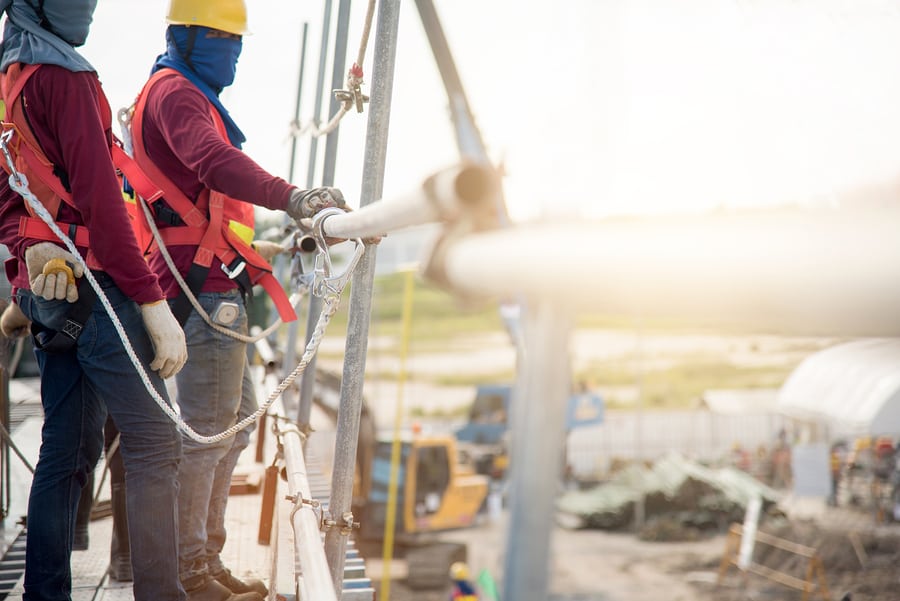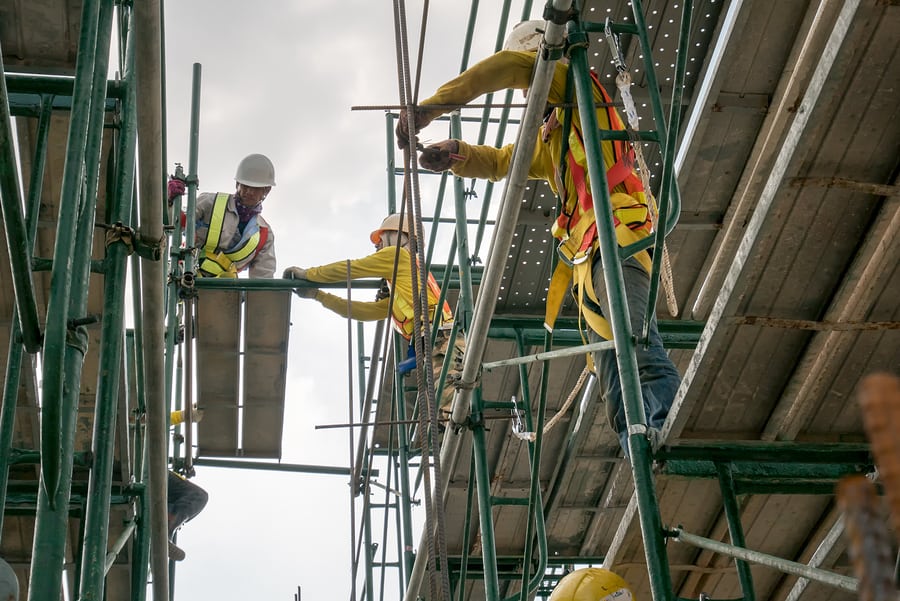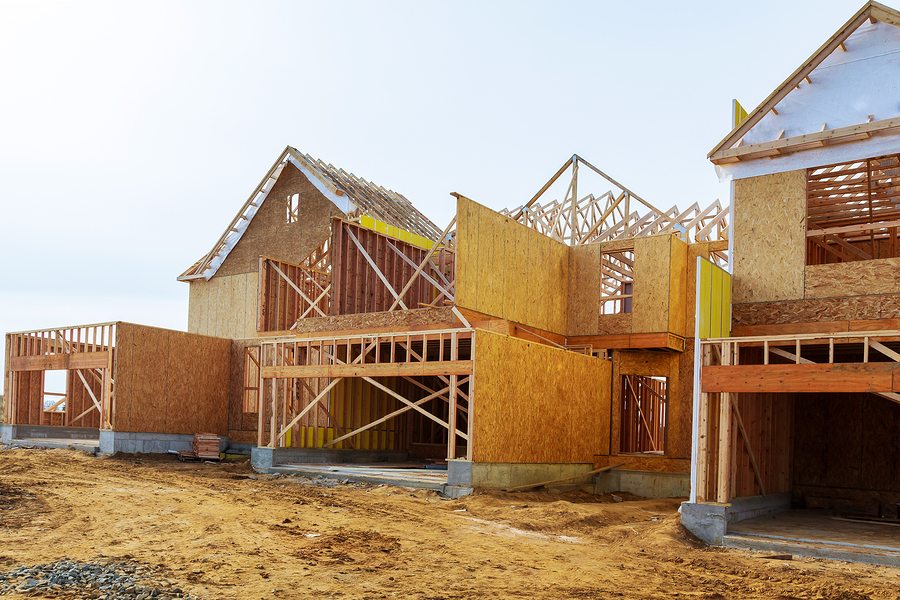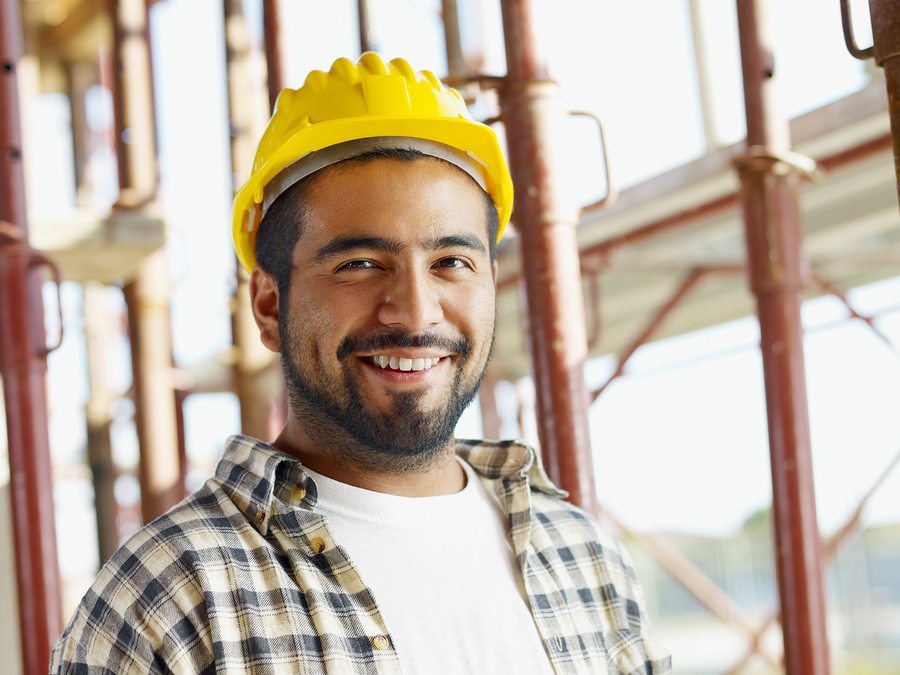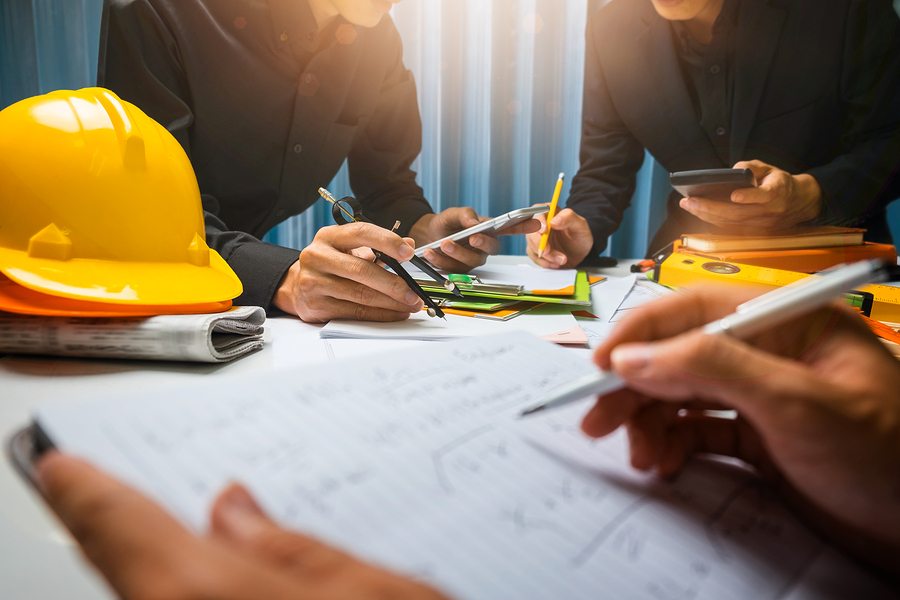by jeffp | Aug 15, 2018 | Construction

Construction sites are inevitably dangerous places to work, housing a myriad of possible hazards and conditions which are conducive to injury. In 2016/2017, construction was unsurprisingly found to be the industry with the most fatal industries present for employees. Nonetheless, if proper precautions are taken, risks can be mitigated. Here we inform you on 5 of the biggest construction site hazards which you should manage.
1. Falling from a height
According to a report from the UK, approximately one-quarter of all worker deaths occur due to falling from a height. Any employee working at height thus needs to be adequately trained in working on a variety of equipment and surfaces at height, using ladders and scaffolding appropriately, as well as any other relevant equipment. Construction site managers must perform a risk assessment which identifies their employees’ risk of falling from heights, ensuring that all appropriate preventive measures are in place and that all employees are adequately trained. If any work being conducted at height could indeed be done on the ground, be sure to take this precaution. Furthermore, consider setting up harnesses and safety nets which would cushion falls if they were to happen.
2. Slips, trips, and falls
Although these can happen in any workplace, construction sites are more likely to be littered with uneven surfaces and debris, making slips, trips, and falls more likely than in typical workplaces. It is thus crucial to maintain work areas and access routes appropriately, ensuring that things such as footpaths and stairs are free from debris or equipment and are well-lit throughout the day. Be sure to keep an eye on things such as cables and cords, especially if cordless tools cannot be used for the tasks at hand. Also, as many parts of a construction site will be exposed to the elements, it is essential to take the proper precautions if snow, rain, or mud affect the surfaces and how slippery they may be. There are many ways to control surfaces which have been made dangerous by the weather, so be sure to read up on this and keep the appropriate supplies close by.
3. Excessive noise
Although it’s not the first thing you might think of, hearing damage is a very real phenomenon and construction sites are full of very noisy equipment which can damage one’s hearing. As a result, it is imperative that an employer assess noise risks and provide the appropriate PPE, such as ear plugs, where necessary. It’s common for people who work in noisy environments to suffer from tinnitus and hearing loss, things which they inevitably regret later in life as their hearing deteriorates further.
4. Asbestos
Asbestos kills around 5,000 workers every year, making it a major risk on certain construction sites. If you’re working on buildings beyond a certain age, you might certainly encounter asbestos. If you move or damage materials which contain asbestos, the fibers are released into the air, then being breathed in by unsuspecting construction workers. Asbestos can cause numerous serious conditions such as asbestosis and lung cancer, so it must be avoided at all costs.
If working on an older building which may contain asbestos, it is important to have an assessment carried out beforehand and inform your workers about where the asbestos is, ensuring they have the proper training to identify potentially asbestos-ridden materials and protect themselves from the associated dangers.
5. Electrical currents
Certain electrical live parts could be harmful or fatal if touched, whether directly or indirectly. Problems can occur when machinery comes in contact with underground or overhead electrical cables, for example, and electric shocks commonly cause workers to retract (instinctively) and fall from heights too. Some construction sites have even been found to have people working on electrical wires who are not licensed electricians, taking their fate into their own hands. Suffice it to say that anyone dealing with live electrical currents should be fully trained to do so.
Construction sites are always inherently dangerous places to work, no matter how many risk assessments you carry out. If you’ve got questions about reducing accidents at construction sites, give us a call today and speak to one of our team!
by jeffp | Jun 8, 2018 | Construction

Active shooter events are occurring on a far too regular basis. The average of active shooters was 6.4 per year in 2000 to 2006, that number has since seen a sharp rise. Between the years of 2007 and 2013, the number almost tripled to an average of 16.4 per year, according to The Department of Homeland Security.
While these events are rare occurrences on a construction site, the reality is, they do occur within the workplace. There is the same risk with other major attacks, such as in the event of vehicle hijacking, which on a construction site, can potentially become fatal.
As it currently stands, there is no law that says construction sites or companies need to put into place protection measures to safeguard their employees from these rare, but potentially fatal events. However, that doesn’t mean that construction companies can’t put into place potentially life-saving protection measures themselves.
The measures could just be simple, like including education on the early warning signs of active shootings, with a guaranteed complaint follow-up system. There are a number of ways that a construction site can approach active shooter protection, including the following four strategies for a safer workplace:
1. ) Work on Correct Worker Response
Response time is one of the biggest shooter prevention strategies, focusing on getting workers to run and hide, and if there is no other possible course of action, to fight. There is already a model in place for active shooter response, both from the Federal Bureau of Investigations (FBI) and the Federal Emergency Management Administration (FEMA). Workers should be educated and trained to follow the recommended actions in the event of an active shooting, which includes three possible reactions:
Response One: Run from the event and find a safe location and call for help.
Response Two: In an event where running is not possible, find the best hiding location nearby and call for help.
Response Three: Use whatever is available to fight the attacker until the threat is gone.
Running drills to practice these emergency responses is one of the best ways to get workers accustomed to what they would need to do in a real scenario.
2.) Understand the Risks
Very often, a potential active shooter will draw attention to themselves before a shooting occurs. Employers and employees are in a prime position to be able to see any changes in their behavior first-hand and address the changes quickly. Incidents that it’s important to be on the lookout for, and address, can include:
- Violent talk or acts of violent behavior, including aggression
- Signs of depression/paranoia
- Sudden habit or hygiene changes
- Threats or threatening gestures and remarks
- Changes in performance at work
- Harm inflicted to themselves or another person
- Destruction of property
- Self-destructive tendencies.
It’s also crucial to be on the lookout for potential workplace security risks, areas where individuals may be able to trespass or think they can, and any warning signs from recently terminated employees.
3.) Be Prepared to Face Threats
Knowing the risks is vital, but so is being ready to face them if it’s ever needed. Establishing a Threat Response Team, that is able to actively aid law enforcement in the local area, and who understand the protocols for emergency response, can greatly aid the workplace.
With a Threat Response Team, employees have somewhere to turn to for advice, information, or even first-aid supplies. It also means that there is a group of people to deal with potential warning signs through investigation.
4.) Work with Law Enforcement
Law enforcement in the local area will be able to provide a wealth of advice on training, protocols, and responses, and also give feedback on performance. They will be the main responder to any reported active shooting, so it’s beneficial to build a relationship with them as early on as possible.
Do you work on a construction site or run a construction company, and are worried about the threat of active shooters? Talk to us today to learn more about essential insurance for a safer workplace and how to get better coverage.
by jeffp | Jun 4, 2018 | Construction

Working in construction has undergone a dramatic change over the last 60 years. Since the 1960s and 1970s, when safety wasn’t the highest priority, construction work has transformed by introducing a whole host of new safety precautions.
However, whilst the precautions account for a large number of the risks associated with working in construction, they haven’t eliminated every danger from the industry. In 2015, according to the Bureau of Labor Statistics, 937 workers were killed in construction, accounting for 21.4% of the full total of worker fatalities in that year. This number is higher than in any other industry sector and marks the highest number of construction fatalities since 2008.
Breaking Down the Statistics
While the full number of fatalities is shocking, when you break it down, the statistics become even more alarming. Those 937 fatalities mean that 18 people a week never came home from work. Tragedies that didn’t have to happen.
To combat the unnecessarily high number of fatalities, more focus needs to be directed towards improving safety conditions – more so than what has already been done. If safety measures aren’t constantly improving, then there is the risk of bouncing back to the days of incredibly poor safety measures.
A Risk That is Rising
The need for heightened measures for safety becomes even more critical when accounting for the increase in workers within the construction sector. 2015 saw the highest level of construction employment since 2008, with 75% of firms having plans to extend their workforce.
The combination of higher amounts of work and increased wages in the construction industry, make improving safety a top priority. This is especially prominent as the heightened demand has led firms to hire workers that are not as qualified or are experienced primarily in different industries.
To combat the growing issue of risk for construction workers, education and training on a continuous basis have become very important.
Construction Training
One of the most important aspects of modern construction safety training is centered around the ‘Construction Focus Four’. The Construction Focus Four are hazards that have been identified as the most prominent by OSHA. These consist of:
- Caught-in/between – accounting for 67 construction fatalities in 2015
- Electrocution – accounting for 81 construction fatalities in 2015
- Struck-by – accounting for 90 construction fatalities in 2015
- Falls – accounting for 364 construction fatalities in 2015
With the vast majority of the accidents, 602, being a direct result of the Construction Focus Four, the emphasis is being put on continuous training – reaching as many small-to-medium sized construction contractors as possible. By directing training at small-sized contractors and subcontractors, the aim is to assist those who otherwise might not have ample resources to do so themselves.
Reducing Risks Through Ongoing Training
Training that continues into the workplace and beyond is of the upmost importance when reducing safety risks. This includes new-employee/experienced-employee mentoring and buddy systems, that can help all construction workers at every level.
Being aware of what other workers are doing and responding with help and assistance is key in making sure that everyone stays safe on the job. Certain programs have been developed to help enforce this through encouragement and rewards, such as the ‘Thumbs Up for Safety’ program.
The program introduces the ‘Countdown to Safety’, which is designed to help workers identify potential hazards and address them. These engaging programs go one step further than the standard rulebook, helping employees to work in a lower risk environment and construction firms put safety as a top priority.
There is still a lot of work to be done, but it seems that the construction industry is starting to make serious positive changes.
Interested in topics about health and safety in construction, and want to learn more about health insurance in the construction industry? Contact us at any time for any insurance questions you might have.
by jeffp | Apr 28, 2018 | Construction

It is important to assess the risks associated with construction projects before looking for insurance. The policy limits and terms in your insurance need to suit to your construction project and must be able to cover any losses you may incur. Construction projects are inherently risky operations, meaning that selecting the right insurance is particularly crucial to a project’s long-term survival.
First of all, let’s look at some of the most common types of construction insurance coverage.
1. Commercial General Liability coverage
When it comes to construction projects, CGL (Commercial General Liability) is the most common form of insurance policy. Standard CGL policies insure commercial enterprises against property damage and bodily injury, with these terms being greater defined in the policy documentation. You should bear in mind, however, that a CGL policy does not cover the cost of repairing defective work; it only covers the damage which results from said defective work. Repair claims usually differ from contract to contract, so it is crucial to pay close attention to the warranty and indemnification processes outlined in the policy.
2. “Umbrella” policies
Umbrella policies are most often useful for large contractors who run large-scale construction projects. An umbrella policy will normally come in addition to a CGL policy, as CGL policies have limits which may not cover all the liabilities at stake. An Umbrella policy allows the contractor to “fill in” this gap, as it were.
3. “Builder’s Risk” policies
This type of coverage protects specific builders from specific workplace dangers that they face regularly. These policies usually require the owner, the subcontractors and the general contractors to be named. Builder’s risk policies can cover the structure itself, as well as the materials involved. Builder’s risk policies usually have terms of duration strictly outlined, and usually cover you in the event of things such as wind, fire, lightning, theft, explosions, vandalism, and much more. Common exclusions from these policies include employee theft, earthquakes, flood damage, government action, wars, damages due to mechanical equipment breakdown, and much more. As with any insurance policy, be sure to read the fine print and find out what you are (and are not) covered for.
4. Professional Liability Coverage
Construction projects involving design usually see most of the professional liability lying with the design professional. As the industry changes, however, increasing amounts of contractors are working as designers and builders too, meaning that they assume the responsibility both for the design and the liability exposures too. People who work in this capacity will often purchase a PLC policy, as CGL is not designed to protect them in the same way.
5. Contractor’s Pollution Coverage policy
Pollution incidents are surprisingly common, and a Pollution Coverage policy provides coverage for third-party claims in the case of bodily injury or property damage. A Pollution Coverage policy may be especially useful if you’re involved in infrastructure, maintenance, demolition, HVAC services, carpentry, or any other similar field.
Advice for selecting a construction insurance carrier
Consider solvency when selecting an insurance carrier. What is their combined ratio? This combined ratio is the combination of the loss ratio and the expense ratio, and is said to indicate how well an insurance carrier is performing. The loss ratio is a measurement of the ratio of adjusting losses and costs against the number of premiums earned. On the other hand, the expense ratio is designed to measure the ratio of incurred business operation costs against written premiums.
If a company’s combined ratio is in excess of 100% for a year, then the insurance company has actually lost money during that period. The A.M Best Company rates insurance companies on a scale from A+ (excellent) to C (fair), taking their solvency into account. Try to aim for insurance carriers with A or A+ ratings!
Also consider whether the insurance carrier is admitted or non-admitted. Admitted carriers must comply with state’s Department of Insurance regulations, whereas non-admitted carriers are not required to comply with these regulations at all. This means that non-admitted carriers can be flexible with their rates, allowing them to provide insurance for higher-risk events which state-approved admitted carriers simply cannot be allowed to provide due to the financial implications.
What with the inevitable risks associated with construction projects, it is essential to acquire the right type of insurance that protects you, your employees, and your property from damages of all kinds. Bear in mind, nonetheless, to focus on what your policy DOES NOT cover, as these are the things which often catch contractors out, especially in high-risk environments such as construction sites.
Are you a contractor looking to find the best insurance policy for your needs? Get in touch for bespoke advice about construction insurance policies in your field and location.
by jeffp | Apr 25, 2018 | Construction

BuildForce Canada estimates that around 21% of the labour force (over 132,000 workers) will retire between the years of 2018 and 2027, necessitating replacements in the near future. A new influx of younger workers is said to meet the new demand, with over 125,000 workers aged 30 and younger now entering the construction industry.
However, there are safety concerns about the sudden influx of younger workers, who are statistically more likely to experience deaths or injuries on construction sites due to their lack of experience in health and safety practices when compared to their older and more experienced counterparts.
Safety and construction associations are aware of this risk, with Tammy Oliver, Senior Director of the BC Construction Safety Alliance, saying that the BCCSA is offering health and safety-related courses to young people who wish (or need) to receive formal safety qualifications for industries such as roadbuilding and construction. The alliance also offers hazard awareness training programs too.
WorkSafeBC is also said to offer health and safety programs to new and emerging workers, with the Young Worker Speaker program being created to assist parent advisory councils and secondary schools that have concerns about young workers’ safety. Spokeswoman Erica Simpson claims that the program supplies speakers with unique experience and skills, allowing them to educate other young people and encourage them to take safety procedures seriously.
Terry Bogyo, a BC consultant, says that young construction worker deaths and injuries are a many-sided issue.
“The loss of limbs, function, and life of anyone is serious, but, in the case of young workers, the potential years of life lost or the disability-adjusted years of life imposed are that much greater.”
Discussing how some younger workers may ignore safety rules in order to impress their new bosses, Bogyo goes on to say “we need a top-down change in what is important on a work site… Supervisors need to make it clear all the time that safety trumps production.”
Bogyo expresses the opinion that the frequent use of safety messages in construction workplace communication will eventually lead to an increase in site safety, as well as a drop in procedure violations.
Training is also a big concern for young construction worker safety, with other countries, such as Australia, being quoted as having superior training systems to Canada, at least when it comes to building sites. Bogyo goes on to explain how the Australian construction training system is designed to ensure that everyone uses the same vocabulary and has the same basic training, ensuring consistency and straightforward communication between workers.
Jeff Lyth, a Vancouver health and safety consultant, says that employers and their workers must think more deeply about hazards and the associated risks if they wish to see a drop in accidents. Many employers simply focus on rule and regulation changes, but Lyth argues that this is not enough to protect construction workers from deaths and injuries in their workplace.
Looking to learn about insurance for construction workers? Get in touch and see what we can do for you today.
by jeffp | Feb 27, 2018 | Construction

More often than not, construction insurance is necessary for each construction project. This kind of insurance typically offers coverage for natural disasters, risks, material, employees, as well as your company. Here are some of the most common insurances for the construction industry.
- Contractor Liability Insurance Coverage
For protection against injuries, property damage, and accidents suffered on the job, there is a need for a good contractor liability insurance coverage. Also, workers in the construction industry can accidentally damage property by mishandling materials and tools, or while a remodeling process is ongoing.
- Builder’s Risk Insurance
This insurance policy covers the payment if there’s any damage as based on the coverage limit. This limit is a solid representation of a given structure’s entire completed value. In other words, it includes all materials and labor cost, without land value. Coverage for damages resulting from faults such as design, planning, materials, and workmanship are not included.
- Performance Bond
In a situation where the contractor is unable to perform or fails to complete the project according to established and provisions of the contract, the performance bond will help to protect the owner against possible losses. The surety will be responsible for reimbursing the owner for losses in cases where the contractor declares bankruptcy or defaults.
- Payment Bonds and Construction Projects
To ensure all subcontractors, material suppliers, and laborers are paid to leave the project lien free, there is a three-way contract, the payment bond, formed between the owner, the contractor, and the surety.
- Professional Liability Insurance
Professional Liability Insurance covers errors caused by Contractor’s carelessness while carrying out his functions under the specified agreement. If your omissions and errors resulting in loss of client investment or if you do not perform your contractor duties, the insurance covers your litigation expenses.
- Flood Insurance
Flood insurance may be beneficial (or required) in situations where a project is located in a flood zone. It is needed for avoiding insurance solicitations when the construction project could be impacted by a flood event.
Construction Insurance Cost Control
By completing your jobs in a timely manner and maintaining excellence in your construction business operations, you can save with smaller premiums and deductibles in your insurance.
On the lookout for other great information about insurance topics? Contact us anytime for all insurance related questions.

